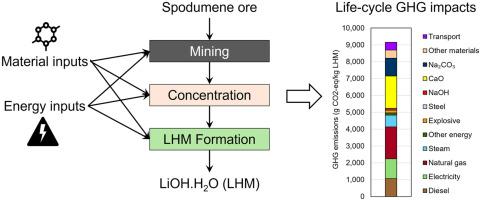芬兰电池级锂生产的生命周期温室气体排放分析
IF 10.9
1区 环境科学与生态学
Q1 ENGINEERING, ENVIRONMENTAL
引用次数: 0
摘要
各国都在积极推进电池相关关键材料的国产化。在芬兰,Keliber Technology Oy正在开发利用锂辉石矿石生产电池级一水氢氧化锂(LHM)的能力。使用Argonne的R&;D GREET(研究与开发温室气体、管制排放和技术中的能源使用)模型,对该途径进行了详细的生命周期评估(LCA),以确定其生命周期温室气体影响。分析显示,生命周期温室气体排放量约为9.2 kg co2当量/kg LHM,主要来自三种能源——柴油、天然气和电力——以及两种材料输入——石灰(CaO)和纯碱(Na2CO3)。敏感性分析强调了使用低碳电力、封存CaO和Na2CO3生产过程中产生的二氧化碳排放以及用于LHM生产的生物基能源(各减少约15% %)来减少这些影响的潜力。一项比较分析表明,与在中国加工的澳大利亚锂辉石矿石生产的现有锂辉石相比,Keliber的锂辉石对锂辉石的影响要小(约40% %)。本文章由计算机程序翻译,如有差异,请以英文原文为准。

Life-cycle greenhouse gas emissions analysis of battery-grade lithium production in Finland
Various countries are undertaking initiatives to domestically produce battery-related critical materials. Within Finland, Keliber Technology Oy is developing capabilities for battery-grade lithium hydroxide monohydrate (LHM) production from spodumene ores. A detailed life-cycle assessment (LCA) of this pathway is conducted to determine its life-cycle GHG impacts using Argonne’s R&D GREET (Research and Development Greenhouse gases, Regulated Emissions, and Energy use in Technologies) model. The analysis shows life-cycle GHG emissions of ∼9.2 kg CO2-eq/kg LHM, dominated by contributions from three energy sources – diesel, natural gas, and electricity – and two material inputs – lime (CaO) and soda ash (Na2CO3). Sensitivity analyses highlight the potential to reduce these impacts using low-carbon electricity, sequestration of process CO2 emissions generated during CaO and Na2CO3 production, and bio-based energy for LHM production (by ∼15 % each). A comparative analysis shows lower impacts for Keliber’s LHM than for existing LHM production from Australian spodumene ores processed in China (by ∼40 %).
求助全文
通过发布文献求助,成功后即可免费获取论文全文。
去求助
来源期刊

Resources Conservation and Recycling
环境科学-工程:环境
CiteScore
22.90
自引率
6.10%
发文量
625
审稿时长
23 days
期刊介绍:
The journal Resources, Conservation & Recycling welcomes contributions from research, which consider sustainable management and conservation of resources. The journal prioritizes understanding the transformation processes crucial for transitioning toward more sustainable production and consumption systems. It highlights technological, economic, institutional, and policy aspects related to specific resource management practices such as conservation, recycling, and resource substitution, as well as broader strategies like improving resource productivity and restructuring production and consumption patterns.
Contributions may address regional, national, or international scales and can range from individual resources or technologies to entire sectors or systems. Authors are encouraged to explore scientific and methodological issues alongside practical, environmental, and economic implications. However, manuscripts focusing solely on laboratory experiments without discussing their broader implications will not be considered for publication in the journal.
 求助内容:
求助内容: 应助结果提醒方式:
应助结果提醒方式:


